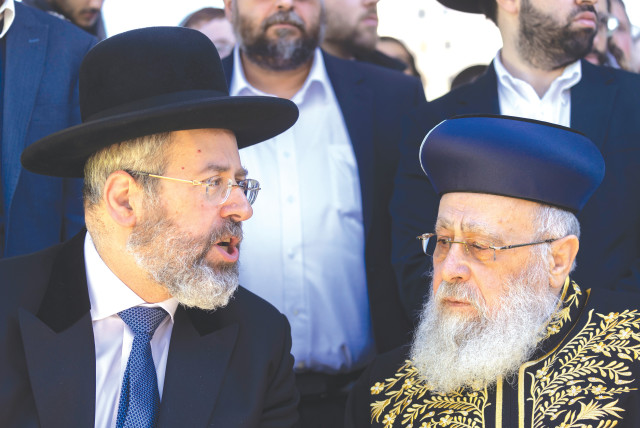Editor's Notes: Chief rabbis retire but did anybody notice?

The Chief Rabbinate must evolve to address the spiritual and practical needs of all Jews in Israel, regardless of their level of observance.
On Monday, the curtains fell on the tenures of Israel’s chief rabbis, Ashkenazi Chief Rabbi David Lau and Sephardi Chief Rabbi Yitzhak Yosef. For the first time since 1921, Israel is without chief rabbis. But if this slipped under your radar, you’re not alone. This wasn’t exactly front-line news. Why? Because these rabbis don’t matter to anyone. Their opinions are about as relevant to most Israelis as a fax machine is in the age of email.
Why don’t we have new chief rabbis yet? According to our sharp-eyed political correspondent Eliav Breuer, the Religious Services Ministry didn’t hold elections in time, thanks to endless disputes over who gets to be on the 150-member election body. It’s like a political version of Survivor, but with more infighting and less charm.
This election body comprises 80 rabbis and 70 elected officials – mayors, religious council leaders, and Knesset representatives. The attorney-general stepped in, ruling that the outgoing rabbis couldn’t appoint their replacements due to, you guessed it, conflicts of interest. The High Court of Justice threw another wrench in the works, demanding that women be considered for these rabbinical positions – a concept they wouldn’t agree to.
Add in the political soap opera. Shas chairman MK Arye Deri tried to install his brother Yehuda as the new Sephardi chief rabbi, but illness stopped that.
Meanwhile, the Ashkenazi haredi parties and the Religious Zionist Party are busy jockeying to get their candidates in place. The High Court has set a deadline of July 7 for appointing new representatives, but don’t hold your breath waiting for a smooth resolution.
The Chief Rabbinate of Israel was established in 1921 under the British Mandate of Palestine to create a centralized religious authority. The first Chief Rabbi, Abraham Isaac Kook, was a visionary, a leader who sought to bridge the gaps between secular and religious Jewish communities. He wasn’t just another political figure in a rabbi’s cloak; he saw the secular Zionist movement as part of a divine plan. Kook famously said, “That which is holy will become renewed, and that which is new will become holy.” He believed that even the non-religious efforts to build the state would eventually align with Jewish spiritual life.
Brandeis University’s Prof. Yehudah Mirsky offered a modern spin on Kook’s views: “Guys, look, these young people rebelling against us aren’t just in it for the cheeseburgers. They’re moving to Palestine, draining swamps, and getting shot at because they think we’ve dropped the ball on Jewish leadership.”
Moving with the times
The Chief Rabbinate has undoubtedly shaped religious life in Israel, overseeing kashrut certification, marriage, divorce, and conversion. It’s the highest halachic authority, issuing rulings on religious law. Yet, the Rabbinate’s monopoly on religious affairs and its exclusion of non-Orthodox Jewish denominations have sparked controversy. It remains influential despite not being universally beloved.
Further, Kook understood the necessity of a military to safeguard the Jewish state and balance defense with higher moral principles. His legacy was one of proactive, positive engagement with challenges: “The purely righteous do not complain of the dark but increase the light.”
Throughout its history, the Chief Rabbinate has faced numerous challenges and controversies. Rabbi Yitzhak HaLevi Herzog, Ashkenazi Chief Rabbi from 1936 to 1959, was a prominent figure who opposed the British White Paper of 1939 and worked to save Jews during the Holocaust. Herzog’s legacy includes significant contributions to both religious and political life in Israel, with his descendants continuing to play prominent roles in public service.
Fast-forward to recent times and we’ve had our fair share of colorful chief rabbis. Rabbi Yona Metzger, for instance, served from 2003 to 2013 and ended in a flurry of legal troubles, namely bribery, fraud, money laundering, theft, and breach of trust. His downfall was a spectacular reminder of the pitfalls of religious leadership mixed with corruption.
Then there’s Rabbi Ovadia Yosef, who made headlines not for crimes but for his incendiary statements. His son, Yitzhak Yosef, hasn’t been shy about controversy either, with remarks about expelling non-Jews and derogatory comments about Arabs.
Once envisioned as a unifying force, the Chief Rabbinate now struggles with political maneuvering and relevance. Many Israelis feel that the institution no longer serves their needs or represents their values. As we approach the July 7 deadline for appointing new representatives, the future of religious leadership in Israel hangs in the balance.
The current situation reflects a broader disconnection between Israel’s religious institutions and its diverse society. Once envisioned as a unifying force, the Chief Rabbinate has become entangled in political maneuvering and struggled to maintain its relevance. This moment of transition offers an opportunity for introspection and reform, potentially paving the way for a more inclusive and representative religious authority.
Looking ahead, the challenge will be to find a balance between tradition and modernity that resonates with contemporary Israeli society. The Chief Rabbinate must evolve to address the spiritual and practical needs of all Jews in Israel, regardless of their level of observance or political affiliation. This moment of transition offers an opportunity for introspection and reform, potentially paving the way for a more inclusive and representative religious authority that can foster unity and uphold the rich heritage of Jewish tradition in a meaningful way for the future.
Jerusalem Post Store
`; document.getElementById("linkPremium").innerHTML = cont; var divWithLink = document.getElementById("premium-link"); if (divWithLink !== null && divWithLink !== 'undefined') { divWithLink.style.border = "solid 1px #cb0f3e"; divWithLink.style.textAlign = "center"; divWithLink.style.marginBottom = "15px"; divWithLink.style.marginTop = "15px"; divWithLink.style.width = "100%"; divWithLink.style.backgroundColor = "#122952"; divWithLink.style.color = "#ffffff"; divWithLink.style.lineHeight = "1.5"; } } (function (v, i) { });

